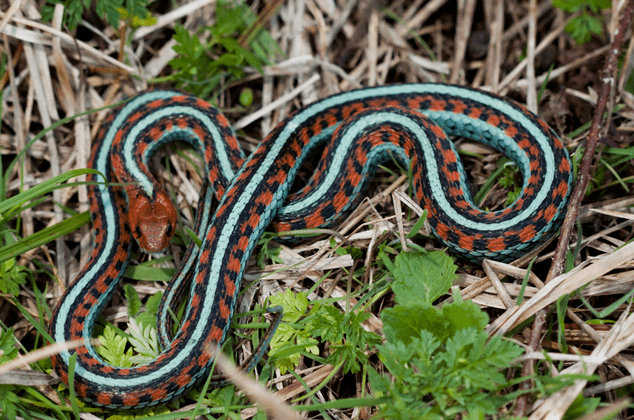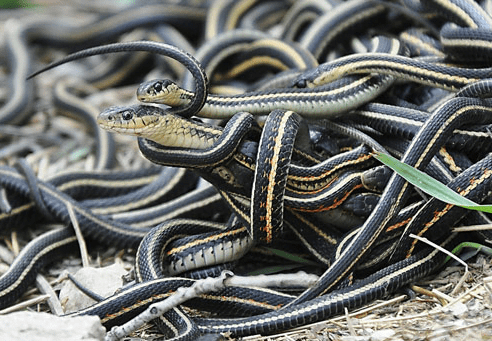The California red-sided garter snake, often known as the red-sided garter, is a North American subspecies of the garter snake. These snakes are among the most colorful in the world due to their unusual coloring. Here are 10 facts about California red-sided garter snakes!
Phylum: Chordata
Class: Reptilia
Order: Squamata
Genus: Thamnophis
1. California red-sided garter snake is huge
The California red-sided garter snake belongs to the Colubridae family. It is a subspecies of the common garter snake which is native to North America. They are easily identified by their special yellow/blue band pattern on a red and black base.
This is a medium-sized snake with the usual size of 36 inches (91 cm). However, they can reach up to 55 inches (140 cm). The males are quite smaller than the females.

Despite their large size, they are incredibly slim, which allows them to have lightsome movements. These snakes can lunge with the speed and agility that few other snakes can match.
Compared to the other family members, the red-sided garter features very big eyes, and the head is just fairly broader than the neck. It has keeled dorsal scales.
2. They have unique scales
California red-sided garter snakes, as well as other garter snakes, have a distinct scale structure and kind. The scales of these snakes are keeled down their bodies. This implies that these scales have a ridge running down the center of them.
The keeled scales are not only for show, they play an important role in the snake’s survival. These scales are not smooth and lustrous, making the snakes’ scales seem dull. This bland appearance makes the snakes more hidden and difficult to spot in the wild.
With this genetic trait, the red-sided garter has a higher chance of surviving in nature. Natural selection has enabled it to become a widespread trait among garter snakes.
3. One of the most colorful snakes
The base color of these snakes is red or red and black blotch. They have lines along the entire of their back and those lines are usually electric blue or yellow.

The snakes also have bands of spots or blotches patterns that run down the backs. These lines can be subtle and typically blend in with the belly color, ranging from yellow-green to blue.
Their head is also red or orange, depending on where it comes from. Juvenile snakes are not different from adults.
The California red-sided garter snake is one of the most colorful animals in the world, you may find related articles below:
- Mantis shrimp and Mandarin fish – the most colorful species in the ocean
- Mandrill – the most colorful mammal
- Lilac-breasted roller and Fiery-throated hummingbird – the most beautiful birds
4. They’re often mistaken for the San Francisco garter snakes
People frequently confuse the red-sided garter with its cousin – the San Francisco garter snake. They frequently overlap in their two patterns. Moreover, patterns differ slightly amongst the snake species.
However, the black on the red-sided snake is sometimes more dominant than the red. This gives it the appearance of the San Francisco garter snake rather than the California red-sided snake. Sometimes, its blue line is often barely visible, and it is identified instead by a bright yellow line.

Because of these changes, it is possible for the red sided California garter snakes to be mistaken for one of their relatives.
The IUCN Red List status of the California red garter snake has not yet been determined. However, the San Francisco garter snake is listed as threatened/ endangered species. The most serious risks to these garter species are habitat destruction and overcollection for the pet industry.
5. Habitat
The California red-sided garter snake lives in California, as the name suggests. They can, however, be found in a variety of locations throughout the US. They locate from northern California’s Humboldt County all the way down to San Diego County.

The red-sided snake is usually found near water. This contains places surrounding streams and ponds, as well as forests, meadows, farmlands, hillsides, and swamps. It also lives around gardens and parks. They like to stay in the water to minimize attention and to escape from any predators or dangers.
6. Behavior
California red-sided garden snakes are diurnal, they are active during the daytime. They are cold-blooded animals, so they have to keep their temperature within 28°-32° C by using thermoregulation. That’s why you can see them frequently lazing in the sun.
In the winter, from late October-early April, the snakes hibernate under rock piles, in logs, holes, and in the burrows of rodents or crayfish.
They communicate with other snakes using skin pheromonal signals. Because each gender of these snakes has its own pheromonal, they gather and analyze chemical signals to follow other garter snakes.
7. They’re not safe as you think
Garter snakes were once thought to be non-venomous snakes, however current research has revealed that they have a deadly toxin. However, you shouldn’t be worried because their venom is just lethal for their prey, not humans. We are too big to be affected by modest amounts of weak poison.

The California red-sided garter snake is not a dangerous snake, to humans. It will almost probably flee if threatened. But it can bite you as a way to defend itself if it is cornered or feel frightened. Don’t be startled if you get bitten by it. Its venom would merely cause minor irritation.
You only need to wash the affected area and cover it. The teeth of the red-sided garter are neither lengthy nor powerful. The wounds won’t be serious enough to necessitate immediate medical attention. If you are afraid that infection, go see a physician for a checkup.
8. Diet
California red-sided garter snakes are neither especially lengthy nor wide in circumference. Therefore, they have a low body mass index (BMI). Because of their limited appetites, they can survive on tiny prey.
Their diet mainly includes insects, slugs, earthworms, reptiles, amphibians, birds, fish, leeches, bird eggs, and small mammals. They can also eat adult Pacific newts that are poisonous to most animals. They preserve the poison of these species to protect themselves from their enemies.

Garter snakes hunt their prey by using techniques like gazing, extending, and ambushing. They have rapid reflexes and keen teeth to immobilize their prey.
Although the California red-sided garter snakes have large teeth, they can’t inject their venom into the prey like other extremely venomous snakes (pit vipers). This is because they don’t have an adequate mechanism to inject venom. That’s why they have to chew their prey to deliver the venom into its bloodstream.
The California red sided garter has quite a few predators. They can be eaten by king snakes, shrews, coral snakes, squirrels, American crows, snapping turtles, hawks, raccoons, and bullfrogs.
9. Reproduction: mating ball
The mating habit of the California red-sided garter snakes is similar to the other garter snakes. Their breeding season takes place in early spring and sometimes in fall, right after their hibernation.
When the snake emerges from hibernation, the males immediately begin looking for females. Whereas the female snakes emit a sex-specific pheromone in order to lure a great number of partners. This frequently results in the development of a mating ball, where males fight for breeding opportunities.

After finding the mate, the male red-sided garter snakes coil themselves around a female in the desire of mating with her first. They literally “lick” the female quickly to collect the smell of her pheromones. This helps the males know a lot of things about their partners; from species, population, gender, and reproductive status, to season, age, and size.
That information is very crucial since the males need the female to be the same species. The size and reproductive status of the female are even more essential, because these will decide the number of snakelets the female can give him.
The males’ purpose is to choose the most productive partner to have as many snakelets as feasible. As a result, larger female California red-sided garter snakes are frequently desired after more than smaller ones.

When finished breeding, the female releases a distinct scent that informs all other candidates that she’s done; the competition is over; there’s a winner. This causes all the other snakes to untangle themselves from her and leave to find another partner.
These other males then repeat the procedure. They seek another appropriate mate, intertwine themselves in massive groups, and find an opportunity to mate with her before another one does.

After reproduction, the female seeks food and a suitable location to give birth after a 60-90 day gestation period. These California red-sided garter snakes are ovoviviparous, meaning they give birth to live snakelets. The clutch size is usually from 8 to 20 offspring.
The offspring are born in the mid-summer to early autumn and are self-sufficient from birth. They often have a length of 5 to 8 inches (12 to 20 cm) and have paler colors.
Most juvenile California red sided snakes are born yellowish. As they age and shed, the colors get bluer and brighter. They reach sexual maturity in 2-3 years and can gain a size of up to 55 cm.
10. They can make good pets
These California snakes can be kept as pets. They are often low-maintenance and gentle. Due to their diminutive size, they don’t need too much room or expensive food. However, California red-sided garter snake price is quite high, about $500. You can buy it online or at pet shops.
Here are a few things you need to know to take care of your California red sided:
– Tank: A tank of 20-gallon is enough. However, you should give them more space if possible. Because in nature, the California red-sided garter snakes can move hundreds of miles in a single year.

– The bedding: Cypress mulch is the most commonly suggested bedding. It’s worth every single penny you pay for. It looks nicer, assists your snake shed better, and it won’t dry up the enclosure.
– Temperate should be between 70*F and 72*F on the ambient side and between 80*F and 82*F on the basking side.
– The water dish should be large enough for your garter snake to stay in as well as drink from. This will allow it to absorb more moisture when needed. The greater the amount of water in the tank, the greater the amount of moisture in the air.
– A hiding hole is necessary for your snake to feel safe and comfortable in its environment. You should put a hole in each side of the tank. Don’t be complicated, a box is enough.

